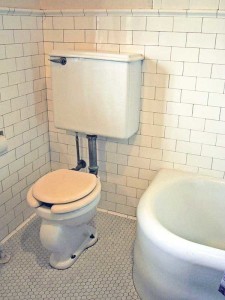Small Home Gazette, Fall 2014
In the Toilet
If you missed the Bungalow Club’s summer 2014 presentation—Design Solutions for Old House Bathrooms, by Lynne Stryker—you missed a lively discussion afterward about the flushing capabilities of toilets, or lack thereof. There were a lot of questions about finding a new toilet that flushes well.
Unfortunately, there were few answers. There’s no guarantee a new toilet will flush well. Purchasing and installing a modern toilet is a labor intensive and expensive gamble. Choose the right toilet, and you’ll enjoy many years of convenience and water savings. Choose the wrong toilet, and you’ll endure many years of double (or triple) flushes, a bowl perpetually soiled with unmentionable matter, a dim opinion of the toilet’s manufacturer, and an even dimmer opinion of the lawmakers who in 1992 limited each flush to 1.6 gallons of water (or recently 1.28 gallons in California).
High Water Mark

An original toilet with wall-mounted tank, located in the 1908 Grey House at Four Mounds in Dubuque, Iowa (www.fourmounds.org).
The earliest 1.6-gallon flush toilets introduced in 1994 didn’t perform well. Over the ensuing years, they’ve gotten better, but there is still a wide range in performance. Several years ago, I stayed at a particular Dallas hotel multiple times over a two-year period. The toilet in every room (the same model was installed throughout the hotel) barely flushed liquids, much less solids. I think I had to call maintenance every time I was a guest.
So—if you’re in the market for a new toilet, how do you choose?
Ask Around
If you know of anyone who recently installed a new toilet, ask how it performs. If they give it a thumbs-up, run out and buy the same model while it’s still available. Manufacturers periodically discontinue older models and introduce new ones, and there’s no guarantee a newer model will flush as well as the old one. Lynne Stryker, who oversees a lot of bathroom re-dos, says that in her experience, one model made by a company can perform well while another from the same company will perform poorly.
Check With Consumer Reports
I know people who installed new toilets in two separate houses, several years apart. In both cases, they checked toilet ratings published by Consumer Reports and purchased recommended models. The toilets, both models manufactured by American Standard, perform admirably. (They tried to determine the toilets’ model numbers, but the paperwork is long gone, and there are no visible numbers on the bowls themselves. Plus, those models are likely discontinued by now.)
Consumer Reports tests toilets on an ongoing basis and periodically updates their ratings online. But there are some caveats. First, you must have a subscription to access the ratings, though you can get just one month of online access for $6.95, or $30 for a year. Second, judging by the readers’ comments included with each model’s review, Consumer Reports’ ratings are not necessarily infallible. Readers pan some toilets rated highly by Consumer Reports, and they praise some models rated poorly by Consumer Reports. Still, it’s somewhere to start. If you’re about to make the long-term commitment to a new toilet, it may be worth the price of a subscription.
Vintage Look?
Though a few contemporary toilets claim to have a supposedly “retro” look, few truly resemble the toilets of yesteryear. The primary difference is that early 20th century toilets had a wall-hung tank that was connected to the bowl by a visible “elbow” pipe. If you want this authenticity, you have two options.
You can purchase a vintage toilet. They were built like tanks back then, and they’re still fairly easy to find. But a licensed plumber cannot legally install them because they don’t meet the 1.6-gallon federal requirement. You can do it yourself if you’re handy, though you’ll have to live with the guilt of wasting about a gallon and a half of water each time you flush. You can mitigate this somewhat by submerging a filled plastic bottle (or bottles) in the tank. This will displace some of the water so less is used per flush. But to reduce the water usage to the 1.6 gallon standard, you’d have to submerge the equivalent of at least 1½ gallons worth of filled bottles in the tank. And it’s questionable as to whether the toilet would effectively flush with that much less water than it was designed for.

The “Lydia” reproduction toilet can be yours for just $995, shipping included, from Bathroom Machineries (www.deabath.com). It uses just 1.28 gallons per flush.
Oh—and the Lydia will set you back $995. At least shipping is free.
If you’ve got really deep pockets and/or a bathroom plumbing fetish, Bathroom Machineries also sells the Lydia bowl with a genuine Thomas Crapper & Co. tank. It’s made in Great Britain by an incarnation of the company that’s been making Crappers since 1861. And it can be yours for just $3,345.











